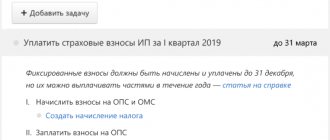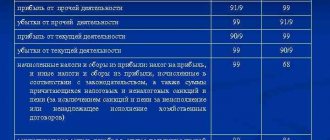The UTII regime has features in calculating the tax burden and reflecting the results obtained in accounting, due to the lack of relationship between actual performance indicators and the amount of tax. The single tax depends on standard indicators, coefficients established by legislative acts of the Russian Federation and its constituent entities for a specific area of activity, and does not depend on the actual income and expense values in the area to which the imputed regime applies. In this article we will look at how UTII is calculated and what transactions are made to account for the tax.
Basic requirements for calculating UTII
The use of this taxation system exempts the payer from paying income and property taxes, except for non-current assets that already have their own cadastral value, as well as VAT and personal income tax - personal income tax.
Payment of UTII must be made no later than the 25th day of the month following the reporting quarter. The posting of UTII accrual must be done on the last day of the quarter.
Important! The amount of UTII tax can be reduced by the amount of insurance premiums that the entrepreneur pays for himself.
In addition, please note that the amount of UTII tax must be accrued and paid even during periods of business downtime or losses.
The use of the special UTII regime is provided only in several areas of activity on the basis of Article 346.27 of the Tax Code of the Russian Federation:
- Household services;
- Veterinary services;
- Hotel services;
- Vehicle washing and repair services;
- Retail;
- Maintenance of catering establishments;
- Outdoor advertising placement;
- Providing housing and commercial properties for rent:
Only those enterprises that meet the requirements established by Article 346.26 of the Tax Code can apply this UTII system, namely:
- The number of hired employees does not exceed 100 people;
- Equity contributions to the authorized capital of other enterprises do not exceed 25%;
- The area of the sales area is no more than 150 square meters;
- The organization is not one of the largest taxpayers.
Description of the tax
UTII acts as a basic mandatory payment made to the budget for small organizations in which up to 100 people work and perform their direct duties.
This is stated in Art. 346.26 of the Tax Code of the Russian Federation. For individual entrepreneurs, the fee replaces personal income tax, VAT and property contributions, and for LLCs it becomes a replacement for income tax and VAT. Using the mode brings convenience from the point of view of reducing costly areas and from the point of view of simplicity in general.
The use of UTII is available only to those organizations that ensure the implementation of their activities strictly in certain areas. This is described in the norms of the current legislation - Art. 346.27 Tax Code of the Russian Federation. This also includes the following common areas:
- provision of veterinary services;
- consumer services;
- hotel service;
- repair work on automatic telephone exchange;
- retail sales of products and goods;
- running a restaurant business;
- advertising placement;
- leasing of commercial and residential real estate.
Moreover, the organization has the right to apply UTII not in relation to all activities, but within the framework of individual areas together with other regimes such as the simplified tax system, OSNO.
Formula for calculating UTII
The UTII tax is calculated based on the level of basic profitability, adjusted by the deflator coefficient K1 and the adjustment coefficient K2. The amount of basic profitability and the types of physical indicators K1 and K2 are established for each type of activity separately, which is prescribed in Article 346, paragraph 29.
The K1 coefficient is set at the federal level for 2021. it is 1.798, and the size of the K2 coefficient is set by local authorities at the place of registration of the company.
Calculation and accrual of UTII tax is carried out quarterly. Calculation formula:
Tax base = Profitability base * physical indicators for 3 months * K1 * K2, where:
- K1 – deflator coefficient;
- K2 – correction factor;
- UTII tax = Tax base * 15%.
If an enterprise has started its work or is deregistered as UTII without having worked the full reporting period, then the tax amount will be calculated for the period actually worked.
For example, a private enterprise is engaged in retail trade. Enterprise registration date: February 05, 2021 Find the amount of UTII tax for the 1st quarter.
Initial data:
- The sales area is 25 square meters;
- The level of basic profitability for this type of activity is 1,800 rubles / square meter;
- K1 for 2021 equal to 1.798;
- K2 is equal to 1.
Calculation:
- The size of the tax base for February = 1800 rubles / sq. m. m * (25 sq. m/28 days * 24 days) * 1,798 * 1 = 69,351.43 rubles;
- The size of the tax base for March = 1,800 rubles/sq. m * 25 sq. m * 1.798 * 1 = 80,910.00 rub.;
- Amount of UTII tax for the 1st quarter = (69351.43 + 80910.00) * 15% = 22,539.21 rubles.
General information
Tax on imputed income is the main mandatory payment to the budget for small enterprises that employ no more than 100 people (Article 346.26 of the Tax Code of the Russian Federation).
Wherein:
| For individual entrepreneurs | It replaces personal income tax, VAT and property tax |
| For LLC | Income tax and VAT |
The use of such a regime is convenient, both from the point of view of reducing the cost of paying taxes, and from the point of view of convenience and ease of maintaining tax and accounting records.
It is important to note that the use of UTII is available only to those companies that operate in certain areas, including (Article 346.27 of the Tax Code of the Russian Federation):
- Providing veterinary services and household services.
- Provision of hotel services.
- Carrying out repairs and washing of vehicles.
- Retail sales of products.
- Maintenance of catering establishments.
- Placement of outdoor advertising.
- Renting residential and commercial properties.
At the same time, the company has the right to use UTII not in relation to all of its activities as a whole, but within the framework of certain areas of operation, along with other tax regimes (STS, OSN).
Basic elements of taxation
The Tax Code of the Russian Federation clearly defines the elements of taxation of entrepreneurs with UTII. They determine the principles of operation, structure and procedure for collecting this mandatory payment.
| Item name | Description |
| Tax payers | LLCs and private entrepreneurs are acting in the area that is considered acceptable within the framework of UTII and do not violate the limits on the number of personnel (100 people), the size of the retail space (150 square meters), the number of cars (20 pieces), and also do not have shares in other companies, exceeding 25% (Article 346.28 of the Tax Code of the Russian Federation). |
| Tax rate | Set at 15%. It is accrued on the so-called imputed income: basic profitability adjusted by the value of the coefficients (Article 346.31 of the Tax Code of the Russian Federation) |
| Taxable period | The calculation and payment of UTII by organizations and entrepreneurs is carried out once a month (Article 346.30 of the Tax Code of the Russian Federation) |
| Single tax object | This is the income that the payer can potentially receive in the presence of a certain set of conditions. In the legislation it is conventionally called imputed income (Article 346.29 of the Tax Code of the Russian Federation) |
| The tax base | Calculated according to the formula prescribed in tax legislation |
Namely:
In this case, the basic profitability is predetermined by the state in the form of a nominal value, which differs for different types of activities.
As for the correction factors, then:
| K1 | Recalculates the tax base based on the level of inflation that has established in the economy |
| K2 | Determined at the regional level and characterizes seasonality, order and other features of conducting a particular type of business |
The physical indicator is a unit in which the result of the company’s activities is measured in terms of UTII, and the number of months demonstrates exactly how many full months in a year the entrepreneur worked, paying a single tax (Article 346.29 of the Tax Code of the Russian Federation).
The transition to UTII is carried out at the voluntary request of the taxpayer himself. To do this, he will need to prepare an application to the Federal Tax Service. After this, the right to charge a single tax will begin to apply from the new financial year.
An automatic transition from UTII to the main mode at any time of the year occurs if the entrepreneur (Article 346.36 of the Tax Code of the Russian Federation):
| Begins to engage in activities | Not falling under UTII |
| Expanding your staff | Exceeds the 100 employee limit |
| Increases the share of participation in other companies | More than 25% |
It is worth noting that in order to register for taxation under the single tax system, a company fills out an application for UTII-1 (for LLC) or UTII-2 (for individual entrepreneurs), and when deregistering - UTII-3 (for LLC) or UTII-4 ( for individual entrepreneurs).
Consideration of any applications to the Federal Tax Service from entrepreneurs and organizations regarding tax on imputed income takes no more than 5 days.
Payment deadlines
Both LLCs and individual entrepreneurs pay a single tax based on the results of the quarter, as mentioned above.
In this case, filling out the declaration and making payment to the treasury must be made no later than the 25th day of the month following the reporting quarter (Article 346.32 of the Tax Code of the Russian Federation).
It is worth noting that submitting documents and making payments is carried out by the Federal Tax Service:
| By place of registration | For individual entrepreneurs |
| At the place of registration | For LLC |
When filling out the declaration, payers must remember that they have the right to reduce the amount of UTII by the amount:
- Contributions to the Pension Fund of the Russian Federation, the Social Insurance Fund, the Social Insurance Fund, if the company uses the labor of hired workers. A private entrepreneur has no right to make similar deductions for himself.
- Costs incurred as a result of paying temporary disability benefits to the company's employees. Such payments can be deducted if the employee’s absence from work is confirmed by sick leave.
According to legal restrictions, all of the above deductions cannot reduce the tax base by more than 50%.
When UTII will be cancelled, see the article: UTII cancellation.
Do I need a cash register for individual entrepreneurs with UTII?
Private entrepreneurs carrying out their activities without hiring employees cannot use the right to deductions.
The main regulatory act regulating the issues of calculation and collection of UTII in Russia is the Tax Code.
It devotes an entire chapter 23.6 to issues of the single tax, the articles of which cover:
| Article | |
| 346.26 | Main characteristics and features of this form of taxation of small enterprises, such as UTII |
| 346.27 | Concepts, terms and definitions used in matters of taxation of individual entrepreneurs and LLCs with a single tax, as well as types of activities that fall under this regime and are not recognized within its framework |
| 346.28 | General characteristics of tax payers and the possibility of replacing other mandatory payments with a single tax |
| 346.29 | Description of the taxable object, the procedure for its determination and the process of calculating the tax base |
| 346.30 | The time that is taken into account when calculating the single tax |
| 346.31 | Establishing the exact tax rate |
| 346.32 | The period during which the tax must be calculated, the declaration must be filled out and paid into the treasury |
More detailed issues are regulated by regulations and instructions of specialized government departments, including the Federal Tax Service, the Ministry of Finance and extra-budgetary funds.
Certain issues regarding the procedure for calculating and accounting for UTII are described in Federal Law-402 “On Accounting”, as well as instructions for maintaining documentation for companies using a simplified system of accounting and tax accounting.
Calculation of UTII: postings
The use of UTII presupposes the exemption of the “imputed” organization from paying income tax. Instead, he pays an “imputed” tax.
Let us remind you that income tax is accrued on the debit of account 99 “Profits and losses” and the credit of account 68 “Calculations for taxes and fees”.
Considering that UTII is essentially an analogue of income tax, the accrual of tax on imputed income is reflected in the same way as the accrual of income tax.
This means that every quarter when a single tax is calculated, an accounting entry is made in the accounting records of the “imputed person” (Order of the Ministry of Finance dated October 31, 2000 No. 94n):
Debit of account 99 – Credit of account 68, subaccount “UTII”
This procedure for calculating UTII is also confirmed by Letter of the Ministry of Finance of the Russian Federation dated December 16, 2004 No. 09-01-07.
The type of business entity has a significant impact on accounting for UTII. If the taxpayer is a legal entity, then accounting can be organized in full or in a simplified format. Individual entrepreneurs may not keep accounting records on UTII. This norm is confirmed by clause 2 of Art. 6 of the Law of 06.12.2011 No. 402-FZ and Letter of the Ministry of Finance of 08.08.2012 No. 03-11-11/233. You can learn more about accounting for individual entrepreneurs on UTII.
The right to use a simplified method of organizing accounting arises for a company provided that it meets the criteria of a small business entity:
- by volume of income;
- by the number of hired personnel;
- by capital structure.
Detailed correspondence with examples
As part of the process of calculating and accruing this fee, entrepreneurs use a whole system of entries, which are subsequently subject to entry into the Income and Expense Book, as well as into the Accounting Journal. As in the execution of other operations, the principle of double entry is relevant and applied here:
- The loan is recorded as a disposal. In modern accounting, this means using only one transaction in an organization and for individual entrepreneurs. This is credit 68, which is associated with settlement transactions for taxes and fees.
- By debit we are talking about receipts, so the main account that appears here is 99 “Profits and losses”. Here the accumulation of all income received by the organization within a certain period of time occurs.
If we take into account the fact that UTII is an analogue of a “profitable” tax, the accrual is reflected in the same way as the accrual of income tax. This indicates that every quarter, when UTII is calculated, a corresponding accounting entry is made in the report, as stated in Order No. 94n of the Ministry of Finance of Russia.
Tax and accounting under UTII for LLC
Despite the fact that the tax base for UTII does not depend on actual income, legal entities on the “imputation” need to organize the reflection of accounting transactions in accounting according to a standard algorithm. Differences with other tax regimes will manifest themselves in the content of accounting policies and the composition of reporting documentation. When organizing accounting, enterprises must:
- develop an accounting policy that will indicate the type of activity of the company and the chosen taxation regime;
- use a complete set of primary documentation of a unified type and created using arbitrary templates;
- systematize information about the work of the company in accounting registers (for a small volume of transactions, the registers can be replaced by a journal of business transactions);
- prepare and submit reports.
In the accounting policy in one of the appendices it is necessary to provide a working chart of accounts. Accounting for UTII allows you to make the working chart of accounts more enlarged - for this purpose several synthetic accounts are combined into one. For example, instead of a set of cost accounts (23, 26, 25, 28, 20 and 29), only account 20 can be used. The justification is information from the Ministry of Finance dated July 19, 2011, No. PZ-3/2010. The norm is relevant for small businesses.
Responsibility for organizing accounting for all segments rests with the management of the company. LLC accounting on UTII must be carried out from the moment of registration of the legal entity. Enterprises account for income and costs using the accrual method according to the rules of PBU 9/99 and PBU 10/99.
A feature of accounting operations on “imputed income” is the need to constantly take into account the values that form the basis for calculating tax on imputed income - physical indicators. The formula for calculating tax liability involves multiplying the current value of profitability with a physical indicator (Article 346.29 of the Tax Code of the Russian Federation).
If the tax accrual is shown not on the last day of the quarter, but earlier, then the regulatory authorities will regard this fact as a deliberate concealment of income receipts. When combining imputation with other tax regimes, accounting for income and costs must be kept separately. This is necessary for the correct derivation of the tax base for each of the taxes within the framework of special regimes.
Working in 1C: features and nuances
A large proportion of individual entrepreneurs and LLCs are engaged in non-manual tax and accounting activities. They use specialized computer programs that automate this process and reduce the cost of services from financial sector specialists. The most common mechanism is 1C, which facilitates the calculation and accounting of this tax.
In the process of setting up the software, it is necessary to choose the single tax system, which will lead to the prompt distribution of household goods. transactions on the necessary accounting accounts. It is worth taking into account the features of the version used and looking at the type of operations, for example, “manually carried out”, “AC and NU actions”, “UTII tax”, etc. In all this, the declaration must be drawn up as of the end date of the last month relating to the reporting quarter .
Thus, this tax system is widespread, but not suitable for all enterprises and organizations. This is evidenced by the norms of current legislation.
Features of calculating UTII in 1C are presented below in the instructions.
Postings on UTII in accounting
Tax obligations for impostors arise quarterly (Article 346.30 of the Tax Code of the Russian Federation). In the transaction journal, the reflection of tax on UTII is similar to the entry for the calculation of income tax. To isolate the tax liability from imputed income, account 68 is detailed by the “UTII” subaccount. On account 68/UTII, credit turnovers indicate the process of calculating taxes, and debit entries indicate the repayment of debt to the budget. On this sub-account, UTII is accrued, the postings look like:
- D99 – K68/UTII – the accrued tax amount is displayed (the justification is contained in the Letter of the Ministry of Finance dated December 16, 2004 No. 09-01-07); with UTII, entries for accrual of the quarterly tax liability are drawn up on the last day of the reporting period;
- D68/UTII – K51 – tax has been paid.
For example, in the 1st quarter the company’s calculated UTII amounted to 8,792.81 rubles. There will be two entries in the accounting:
- D99.1 – K68/UTII in the amount of 8792.81 rubles, the fact of accrual of liabilities (data taken from the accounting certificate);
- D68/UTII – K51 – transfer of tax to the budget, confirmed by a payment order.
At the end of the annual period, the amounts accumulated in account 99 will be debited to account 84.
Accounting entries in retail trade under UTII should contribute to the full disclosure of information about incoming material assets, calculated markups and financial results of all purchase and sale transactions. Tax accounting under this special regime is characterized by the absence of calculations of VAT obligations.
With UTII, transactions for the purchase of goods and other valuables have the form:
- D41.2 – D60 – shows the receipt of goods and their acceptance for accounting;
- D41.2 – K42 – mark-up has been calculated.
After selling goods, the company records:
- D50 (51) – K62 – payment received;
- D62 – K90.1 – amount of revenue received;
- D90.2 – K41.2 – the cost of the sold batch of goods is written off;
- D90.2 – K42 – entry for reversing the previously accrued markup.
The accrual of “imputed” tax does not depend on actual revenue; the entries for the accrual and payment of UTII will be the same as indicated above.
Simplified way of accounting
As noted above, for companies on UTII it is possible to maintain accounting records in a simplified form.
Criteria for classifying companies as micro and small enterprises:
| Criteria | Limit |
| Number of employees | 15 people for micro-enterprises 16-100 people for small enterprises |
| Income for the year | 120 million rubles for micro-enterprises 800 million rubles for small enterprises |
If the above criteria are met, the company is considered a small enterprise and has the right to conduct accounting in a simplified form. This allows companies not to disclose information in detail in accounting reports, but to indicate it in a generalized form.
Responsibility for organizing accounting rests with the head of the company. A company must keep accounting records on UTII from the moment of its registration. The main feature of accounting operations on UTII is the constant recording of values that are the basis for calculating tax. They are physical indicators.
Important! If UTII is combined with other tax regimes, accounting for income and expenses for each regime must be kept separately. This is required for the correct formation of the tax base for each tax within a particular regime.
Companies and individual entrepreneurs have tax obligations on UTII every quarter (346.30 of the Tax Code of the Russian Federation). In order for the tax liability for imputed income to be taken into account separately, the “UTII” subaccount to account 68 is used. In this account, credit turnovers reflect the accrual of taxes, and debit turnovers indicate the repayment of obligations to the budget. The specified subaccount reflects the accrual of UTII, and the following transactions are generated:
| Business transaction | Wiring | |
| D | TO | |
| The amount of UTII tax accrued | 99 | 68 (sub-account “UTII”) |
| UTII tax has been paid to the budget | 68 (sub-account “UTII”) | 51 |
Important! Postings for calculating tax on UTII for the quarter are formed on the last date of the reporting period. For example, for the first quarter of 2021, tax must be calculated on March 31, 2019.
At the end of the year, the amounts accumulated on account 99 are written off to account 84. Retail companies on UTII, when creating transactions, must fully disclose information about incoming valuables, accrued markups, as well as the financial results of transactions. For tax accounting, imputation is distinguished by the absence of calculation of value added tax obligations.
Postings for UTII associated with the purchase of goods or other valuables will be as follows:
| Business transaction | Wiring | |
| D | TO | |
| Goods have been received and accepted for accounting | 41.2 | 60 |
| Extra charge added | 41.2 | 42 |
After the goods are sold, the following transactions will need to be generated:
| Business transaction | Wiring | |
| D | TO | |
| Payment received from buyer | 50 (51) | 62 |
| Revenue received is reflected | 62 | 90.1 |
| Cost of goods sold written off | 90.2 | 41.2 |
| An entry was made to reverse the markup | 90.2 | 42 |
In this case, the calculation of UTII tax will not depend on the revenue actually received by the company, therefore the entries for the calculation and payment of tax will be the same as indicated above, that is:
D99 K68 (UTII sub-account) – UTII tax is charged;
D68 (UTII sub-account) K51 – UTII tax is transferred to the budget.
Rate the quality of the article. We want to become better for you: accounting, UTII Tags: accounting, UTII, Calculation of UTII postings, postings
Responsibility
Attention: for violation of the Procedure for conducting cash transactions, the rules for using cash registers, the organization may be fined by the tax inspectorate (Clause 1, Article 7 of the Law of May 22, 2003 No. 54-FZ, Article 7 of the Law of March 21, 1991 No. 943-1 , Article 23.5, 28.3 of the Code of Administrative Offenses of the Russian Federation).
The amount of the administrative fine for non-use of cash registers, as well as for refusal to issue documents confirming the receipt of cash, is:
- for an organization – from 30,000 to 40,000 rubles;
- for officials of the organization (for example, a manager) - from 3,000 to 4,000 rubles.
Such penalties are provided for in Article 14.5 of the Code of the Russian Federation on Administrative Offences.
For failure to comply with cash balance limits, non-receipt (incomplete receipt) of money to the cash register, violation of cash settlement limits with other organizations, the amount of the administrative fine is:
- for an organization – from 40,000 to 50,000 rubles;
- for a manager or chief accountant – from 4,000 to 5,000 rubles.
This is stated in Article 15.1 of the Code of the Russian Federation on Administrative Offenses.
Tax inspectors can detect these violations during an audit of the organization. The tax inspectorate can fine an organization only within two months after the violation was committed (Article 4.5 of the Code of Administrative Offenses of the Russian Federation).









